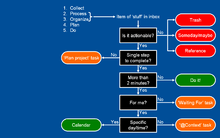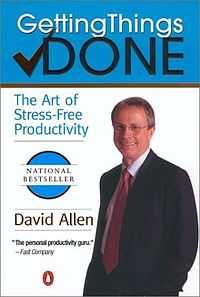Getting Things Done
|
Getting Things Done: The Art of Stress-Free Productivity cover | |
| Author | David Allen |
|---|---|
| Subject | Business |
| Publisher | Penguin |
Publication date | 2002 |
| Pages | 267 pp |
| ISBN |
ISBN 978-0-14-200028-1 Reprint Edition |
| OCLC | 51540420 |
Getting Things Done is a time-management method, described in a book of the same title by productivity consultant David Allen. It is often referred to as GTD.
The GTD method rests on the idea of moving planned tasks and projects out of the mind by recording them externally and then breaking them into actionable work items. This allows one to focus attention on taking action on tasks, instead of on recalling them.
Methodology
Allen's approach uses two key elements — control and perspective. He proposes a workflow process to control all the tasks and commitments that one needs or wants to get done. The goal of the control processes in GTD is to get everything out of one's head. Once a person has a "mind like water", they will regain clear vision on perspectives which include six "horizons of focus".
- current actions
- current projects
- areas of responsibility
- 1-2 year goals
- 3-5 year goals
- 5 Life
Unlike some theories, which focus on top-down goal-setting, GTD works in the opposite direction. Allen argues that it is often difficult for individuals to focus on big picture goals if they cannot sufficiently control the day-to-day tasks that they frequently must face. By developing a system that clarifies and defines the regular workday, an individual can free up mental space to begin moving up to the next level of focus.
A weekly review is done on different levels, and suggests that the perspective gained from these reviews should drive one's priorities. This in turn determines the priority of the individual tasks and commitments gathered during the workflow process. During a weekly review, determine the context for the tasks and put them on the appropriate lists. An example of grouping together similar tasks would be making a list of outstanding telephone calls, or the tasks / errands to perform while downtown. Context lists can be defined by the set of tools available or by the presence of individuals or groups for whom one has items to discuss or present.
GTD is based on storing, tracking and retrieving the information related to the things that need to get done. Mental blocks we encounter are caused by insufficient 'front-end' planning. This means thinking in advance, generating a series of actions which can later be undertaken without further planning. The human brain's "reminder system" is inefficient and seldom reminds us of what we need to do at the time and place when we can do it. Consequently, the "next actions" stored by context in the "trusted system" act as an external support which ensures that we are presented with the right reminders at the right time. As GTD relies on external memories, it can be seen as an application of the theories of distributed cognition or the extended mind.[1]
Workflow

The GTD workflow consists of five stages: capture, clarify, organize, reflect, and engage. (Older editions use the names collect, process, organize, plan, and do). Once all the material is captured in an inbox, each item is clarified and organized by answering "What is it?" questions as shown in the black boxes in the logic tree diagram. As a result, items end up in one of the eight oval end points in the diagram (trash, someday/maybe list, reference filing system, task to create a project plan, done in under two minutes, delegated "waiting for" list, a context-based single-step task list, or on the calendar). Next, project planning occurs. Multi-step projects are assigned a desired outcome and a single "next action." Finally, the tasks on the appropriate context-based task list are worked on unless the calendar dictates otherwise.[2]
Reception
In 2005, Wired called GTD "A new cult for the info age",[3] describing the enthusiasm for this methodology among information technology and knowledge workers as a kind of cult following. Allen's ideas have also been popularized through the Howard Stern Show (Stern referenced it daily throughout 2012's summer) and the Internet, especially via blogs such as 43 Folders,[4] Lifehacker,[5] and The Simple Dollar.[6]
In 2005, Ben Hammersley interviewed David Allen for The Guardian article titled "Meet the man who can bring order to your universe",[7] saying: "For me, as with the hundreds of thousands around the world who press the book into their friends' hands with fire in their eyes, Allen's ideas are nothing short of life-changing".
In 2007, Time Magazine called Getting Things Done the self-help business book of its time.[8]
In 2007, Wired ran another article about GTD and Allen,[9] quoting him as saying "the workings of an automatic transmission are more complicated than a manual transmission... to simplify a complex event, you need a complex system".
A paper in the journal Long Range Planning by Francis Heylighen and Clément Vidal of the Free University of Brussels showed "recent insights in psychology and cognitive science support and extend GTD's recommendations".[1]
Software implementations
While GTD material is technologically neutral and advises people to start with a paper-based system,[10] many task management tools claim to implement GTD methodology.[11]
The following software applications are designed for this purpose.
The entries marked with an asterisk ( * ) are listed on the "Common Tools and Software" page that David Allen maintains. In addition, entries marked with two asterisks (**) are designated "GTD Enabled", meaning David Allen was directly involved in the design.[12]
|
|
See also
References
- ↑ 1.0 1.1 Heylighen, Francis; Vidal, Clément (December 2008). "Getting Things Done: The Science behind Stress-Free Productivity" (PDF). Long Range Planning: International Journal of Strategic Management 41 (6): 585–605. doi:10.1016/j.lrp.2008.09.004. ISSN 0024-6301.
- ↑ David Allen (2001). "Getting Things Done: Five Simple Steps That Apply Order To Chaos". gettingthingsdone.com. Retrieved 2015-01-04.
- ↑ Andrews, Robert (2005-07-12). "A new cult for the info age". Wired.com (Condé Nast). Retrieved 2010-03-05.
- ↑ Mann, Merlin (2004-09-08). "Getting started with "Getting Things Done"". 43 Folders. Retrieved 2010-03-05.
- ↑ Robinson, Keith (2006-03-21). "Best of GTD". Lifehacker. Retrieved 2010-03-05.
- ↑ "Review: Getting Things Done". The Simple Dollar. 2007-05-06. Retrieved 2010-03-05.
- ↑ Hammersley, Ben (2005-09-28). "Meet the man who can bring order to your universe". The Guardian (London: Guardian News and Media Limited). Retrieved 2010-03-05.
- ↑ "The Oracle of Organization". Time. 2007-03-12. Retrieved 2010-03-05.
- ↑ Wolf, Gary (2007-09-25). "Getting Things Done Guru David Allen and His Cult of Hyperefficiency". Wired.com. Retrieved 2010-03-05.
- ↑ Forrister, Kelly (2010-08-02). "Which list manager should I use for GTD?". GTD Times. The David Allen Company. Archived from the original on 2010-08-06. Retrieved 2015-01-04.
- ↑ Forrister, Kelly. "Simply GTD with Kelly: Getting Started". The David Allen Company. Archived from the original on 2010-08-29. Retrieved 2010-08-22.
If you're at all familiar with GTD you know that David Allen does not tell you which tools to use--GTD is tool agnostic--so those choices are up to you. Not saying all tools, software programs, paper planners work seamlessly with GTD, but where you organize your stuff is up to you.
- ↑ "Common Tools & Software". Getting Things Done website. David Allen Co. Retrieved 2014-05-30.
Further reading
- Allen, David (2001). Getting Things Done: The Art of Stress-Free Productivity. Penguin Books. ISBN 0-14-200028-0.
- Allen, David (2003). Ready for Anything: 52 Productivity Principles for Work and Life. Viking Books. ISBN 0-670-03250-6.
- Allen, David (2008). Making it All Work. Viking Books. ISBN 978-0-7499-4103-1.
